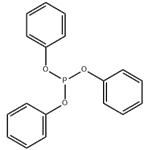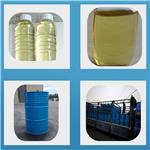- Triphenyl phosphite
-

- $100.00 / 1KG
-
2023-12-24
- CAS:101-02-0
- Min. Order: 1KG
- Purity: 99%
- Supply Ability: g-kg-tons, free sample is available
- Triphenyl phosphite
-

- $10.00 / 1bottle
-
2023-09-14
- CAS:101-02-0
- Min. Order: 1bottle
- Purity: 99%
- Supply Ability: 100MT
|
| | Triphenyl phosphite Chemical Properties |
| Melting point | 22-24 °C (lit.) | | Boiling point | 360 °C (lit.) | | density | 1.184 g/mL at 25 °C (lit.) | | vapor density | 10.7 (vs air) | | vapor pressure | 5 mm Hg ( 205 °C) | | refractive index | n20/D 1.59(lit.) | | Fp | 425 °F | | storage temp. | Store below +30°C. | | solubility | methanol: 25 mg/mL, clear | | form | Liquid | | color | Clear colorless to pale yellow | | PH | 1 (200g/l, H2O, 20℃) | | Water Solubility | insoluble | | Sensitive | Air & Moisture Sensitive | | BRN | 1079456 | | Dielectric constant | 3.2(24℃) | | Stability: | Stable. Combustible. Incompatible with strong oxidizing agents. | | InChIKey | HVLLSGMXQDNUAL-UHFFFAOYSA-N | | CAS DataBase Reference | 101-02-0(CAS DataBase Reference) | | NIST Chemistry Reference | Phosphorous acid, triphenyl ester(101-02-0) | | EPA Substance Registry System | Triphenyl phosphite (101-02-0) |
| | Triphenyl phosphite Usage And Synthesis |
| Secondary antioxidants | Triphenyl phosphite is called for short TPP, it is also known as triphenoxytitanium phosphine, it is phosphite-based compound, it is a secondary antioxidant, it has light stabilizing effect, it is applicable to polyvinyl chloride, polypropylene, polystyrene, poly acetate, ABS resin, epoxy resin and the like. Triphenyl phosphite is widely used as polyvinyl chloride chelating agent, when the metal soap is used as stabilizer, coordinating with this product can reduce the harm of the metal chlorides, it can keep transparency of product and inhibit the change in color. Further triphenyl phosphate is also used as flame retardant plasticizer.
Phosphite phenyl diisooctyl can be obtained by the transesterification reaction of triphenyl phosphite and isooctanol in the presence of catalyst, phosphite phenyl diisooctyl can be used as secondary antioxidant. It has good resistance to discoloration, it can increase oxidation resistance and light stability. It has chelating action in PVC, low toxicity, it can be used in plastic medical devices.
In addition, this product in the presence of sodium methoxide can proceed the transesterification reaction with methanol to form trimethyl phosphite.
Triphenyl phosphite is as raw material, it can react with octanol in the solution of sodium methoxide, octyl diphenyl phosphite can be prepared.
The above information are collated by Xiaonan edit Chemicalbook (2016-12-03). | | Physical and chemical properties | It is colorless or pale yellow oily liquid. It has slightly with phenol odor. Molecular weight is 310. Color (APHA) <50. Acid value is <0.5mgKOH/g. Phosphorus content is 10%. The relative density is 1. 180~1.186 (25°/ 15.5℃). Viscosity is 12 mPa•s (38℃), 4.5mPa•s (99℃). The freezing point is 19~24℃. Melting point is 22~25℃. Boiling point is 220℃ (1333Pa). Flash point (open cup) is 218.3℃, ignition point is 243℃. Refractive index is 1.5880 ~1.5900 (25℃). Solubility (g/100g solvent): methanol> 10, benzene> 10 acetone> 10, it is insoluble in water. Triphenyl phosphate has irritating to the skin, rat oral LD50 is 2800mg/kg body weight, it is used as polymer antioxidant and stabilizer, it has better synergy effect with many phenolic antioxidants. By effect of phosphorus trichloride and phenol can get triphenyl phosphite. | | Chemical properties | It is colorless to pale yellow monoclinic crystal below room temperature. It is colorless light yellow transparent oily liquid at room temperature or higher, it has pungent odor. It is insoluble in water, soluble in organic solvents such as ethanol, ethyl ether, acetone, benzene and the like. | | Uses | (1) Triphenyl phosphite is used as chelating agents, plastics antioxidant, alkyd resin and pesticide intermediate raw material.
(2) It is used for synthetic rubber and resin stabilizer, PVC antioxidant, alkyd resin and pesticide intermediate raw material.
(3) Triphenyl phosphite is used as secondary antioxidants, it has effect of light stability, it is suitable for polyvinyl chloride, polypropylene, polystyrene, polyester, ABS resin, and epoxy resin. (4) It is used as chelating agent in PVC products, it can enable products to maintain transparency, and suppresse color change. It can also be used for the production of trimethyl phosphite.
(5) Antioxidants, stabilizers TPPi is mainly applied to polyvinyl chloride, polyethylene, polypropylene, polystyrene, polyester, ABS resin, epoxy resin, synthetic rubber antioxidant stabilizer for PVC vinyl products as chelating agent, when the metal is as based stabilizer, coordinating with the product can reduce the harm of metal chloride
(6) Chelating agent. Plastic products antioxidant. The synthesis of alkyd resins and polyester resins.
(7) Chelating agent. Plastic products antioxidant. The synthesis of alkyd resins and polyester resins.
(8) Chelating agent, it is widely used in all kinds of PVC products, it can enable products to maintain its transparency and suppress color change, and it can increase the antioxidant and light and heat stability of the primary stabilizer. In addition, the product is also used for PE, PP, ABS, SBS and other products, and it can be used for pesticide intermediates. It can be used for synthetic alkyd resins and polyester materials and polyester resins. | | Uses | Triphenyl phosphite (TPP) is the chemical compound with the formula P(OC6H5)3. This colourless viscous liquid is the ester of phosphorous acid and phenol. It is used as a ligand in organometallic chemistry. Nickel complexes of this ligand are homogeneous catalysts for the hydrocyanation of alkenes.
| | Production methods | It can be obtained from phenol and phosphorus trichloride. Raw material consumption (kg/t) phenol (freezing point ≥40.4 ℃) 940 phosphorus trichloride (99%) 480 | | Toxic Effects | The primary toxic effects of triphenyl phosphite are exerted on the nervous system of susceptible animals. The univeral signs of triphenyl phosphite neurotoxicity result from the irreversible inhibition of acetylcholinesterase (AChE) at cholinergic synapses in the central, peripheral and autonomic nervous system. Triphenyl phosphite is also capable of producing characteristic delayed neurotoxic effects that are manifested several days or weeks after even minimal drug exposure. Such actions are not related to AChE inhibition and the precise biochemical mechanism(s) leading to the delayed neurotoxicity symptoms are largely unresolved.
| | Chemical Properties | Water-white to pale-yellow solid or oily
liquid; pleasant odor. Combustible. | | Uses | Triphenyl phosphite can be used:
- As a source of phosphorus and as a ligand for the synthesis of transition metal phosphide nanoparticles via heating-up process.
- To convert alcohols to alkyl halides.
- As a peptide coupling agent.
- As a low-temperature source of singlet oxygen after forming an adduct with ozone.
- To synthesize bromotriphenoxyphosphonium bromide, a brominating agent, by reacting with bromine.
| | Uses | Stabilizer/antioxidant for vinyl plastics
and polyethylene, polypropylene, styrene
copolymers, and rubber. | | Uses | Chemical intermediate, stabilizer systems for
resins, metal scavenger, diluent for epoxy resins. | | Air & Water Reactions | Insoluble in water. | | Reactivity Profile | Organophosphates, such as Triphenyl phosphite, are susceptible to formation of highly toxic and flammable phosphine gas in the presence of strong reducing agents such as hydrides. Partial oxidation by oxidizing agents may result in the release of toxic phosphorus oxides. | | Health Hazard | Triphenyl phosphite (TPP) is a
skin irritant and sensitizer in humans and is
neurotoxic in laboratory animals.Systemic effects have not been reported in
humans. | | Safety Profile | Poison by
intraperitoneal and subcutaneous routes.
Moderately toxic by ingestion. An
experimental eye and severe human skin
irritant. Combustible when exposed to heat
or flame. To fight fire, use CO2, mist, dry
chemical. When heated to decomposition it
emits toxic fumes of POx. See also
PHENOL. | | Purification Methods | Its ethereal solution is washed succesively with aqueous 5% NaOH, distilled water and saturated aqueous NaCl, then dried with Na2SO4 and distilled under vacuum after evaporating the diethyl ether. [Walsh J Am Chem Soc 81 3023 1959, Verkade & Coskren in Organo Phosphorus Compounds (Kosolapoff & Maier eds) Wiley Vol 6 pp 211-577 1973, Beilstein 6 IV 695.] |
| | Triphenyl phosphite Preparation Products And Raw materials |
| Raw materials | Phosphorus trichloride-->Phenol-->Phosphorous acid, 2,6-diethylphenyl 2-ethylphenyl phenyl ester-->Phosphorous acid, 2,6-diethylphenyl diphenyl ester-->Phosphorous acid, 2,2-dimethylpropyl diphenyl ester-->Phosphorous acid, bis(2,2-dimethylpropyl) phenyl ester-->Phosphonic acid, methyl-, 2,2-dimethylpropyl phenyl ester (9CI)-->Phosphorous acid, 2-(1-methylethyl)phenyl diphenyl ester | | Preparation Products | Triphenylphosphine-->Trimethyl phosphite-->Tetrachlorvinphos-->Unsaturated polyester resin-->Triphenyl phosphate-->polyester-based liquid crystalling ionmer containing sulfonate group-->Scale inhibitor-->Tris(2-chloroethyl) phosphate-->O,O'-Dioctadecylpentaerythritol bis(phosphite)-->bis(2-ethylhexyl) phenyl phosphite-->3-Hydroxydiphenylamine-->Neopentyl iodide |
|